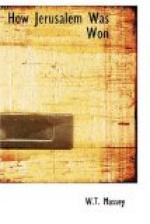when riding. Thus did the British Army play the
game, for some of the Allied susceptibilities might
have been wounded if the people had been told (though
indeed they knew it) that they were under the protection
of the British flag. They had the most convincing
evidence, however, that they were under the staunch
protection of the British Army. The doubling
of the railway track went on apace. To save pressure
at the Alexandria docks and on the Egyptian State railway,
which, giving some of its rolling stock and, I think,
the whole of its reserve of material for the use of
the military line east of the Canal, was worked to
its utmost capacity, and also to economise money by
saving railway freights, wharves were built on the
Canal at Kantara, and as many as six ocean-going steamers
could be unloaded there at one time. By and by
a railway bridge was thrown over the Canal, and when
the war was over through trains could be run from
Cairo to Jerusalem and Haifa. Kantara grew into
a wonderful town with several miles of Canal frontage,
huge railway sidings and workshops, enormous stores
of rations for man and horse, medical supplies, ordnance
and ammunition dumps,
etc. Probably the enemy
knew all about this vast base. Any one on any
ship passing through the Canal could see the place,
and it is surprising, and it certainly points to a
lack of enterprise on the part of the Germans, that
no attempt was made to bomb Kantara by the super-Zeppelin
which in November 1917 left its Balkan base and got
as far south as the region of Khartoum on its way
to East Africa, before being recalled by wireless.
This same Zeppelin was seen about forty miles from
Port Said and a visit by it was anticipated.
Aeroplanes with experienced pilots and armed with the
latest anti-Zeppelin devices were stationed at Port
Said and Aboukir ready to ascend on any moonlight
night when the hum of aerial motor machinery could
be heard. The super-Zeppelin never came and Kantara’s
progress was unchecked.
The doubled railway track was laid as far as El Arish
by the time operations commenced, and this was a great
aid to the railway staff. Every engine and truck
was used to its fullest capacity, and an enormous
amount of time was saved by the abolition of passing
stations for some ninety miles of the line’s
length. Railhead was at Deir el Belah, about
eight miles short of Gaza, and here troops and an army
of Egyptian labourers were working night and day, week
in week out, off-loading trucks with a speed that
enabled the maximum amount of service to be got out
of rolling stock. There were large depots down
the line too. At Rafa there was a big store of
ammunition, and at Shellal large quantities not only
of supplies but of railway material were piled up
in readiness for pushing out railhead immediately the
advance began. A Decauville, or light, line ran
out towards Gamli from Shellal to make the supply
system easier, and I remember seeing some Indian pioneers
lay about three miles of light railway with astonishing
rapidity the day after we took Beersheba. Every
mile the line advanced meant time saved in getting
up supplies, and the radius of action of lorries,
horse, and camel transport was considerably increased.




